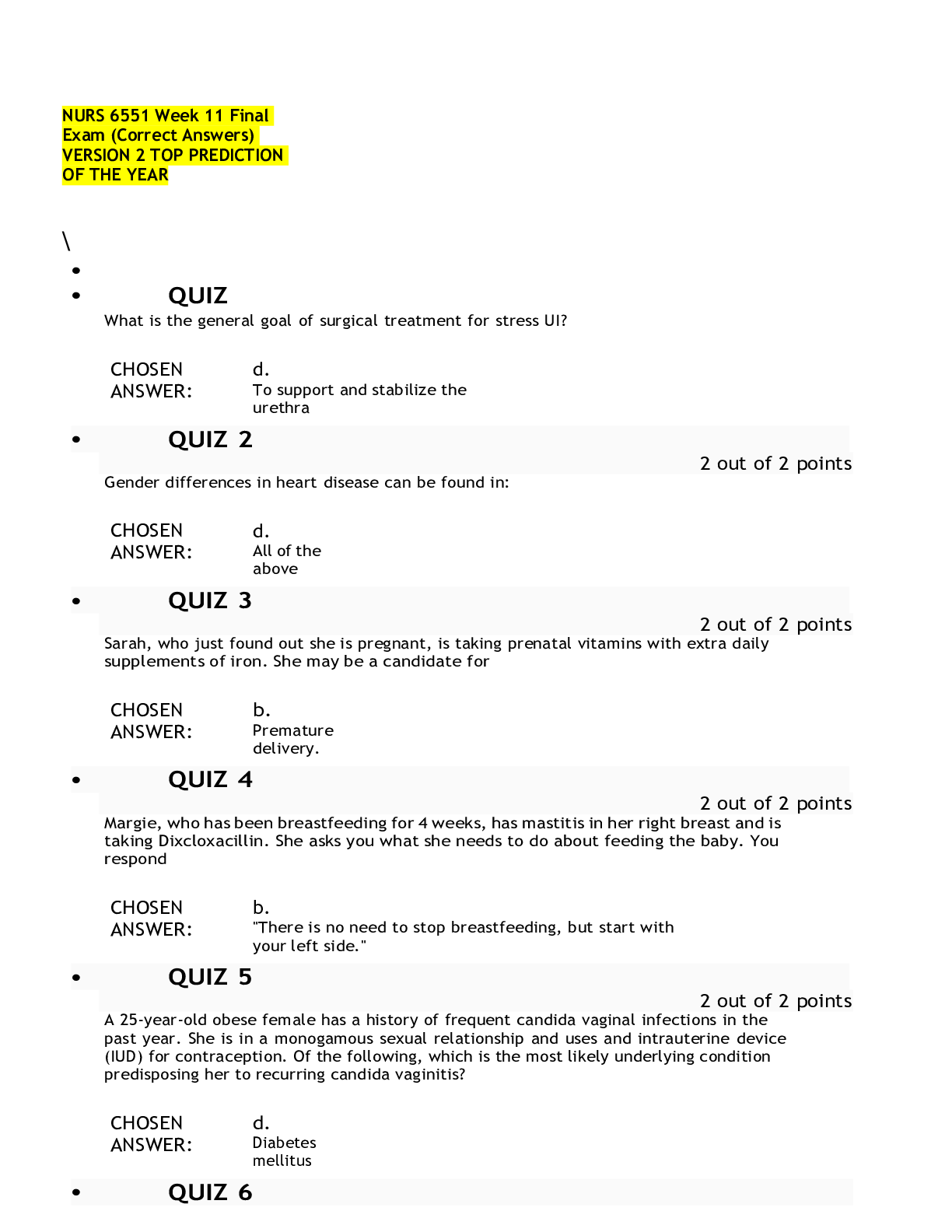Health Care > EXAM > NRNP 6560 FINAL EXAM TEST BANK 2023-2024 REAL EXAM 200+ QUESTIONS AND CORRECT ANSWERS WITH RATIONAL (All)
NRNP 6560 FINAL EXAM TEST BANK 2023-2024 REAL EXAM 200+ QUESTIONS AND CORRECT ANSWERS WITH RATIONALES |AGRADE |WALDEN UNIVERSITY
Document Content and Description Below
NRNP 6560 FINAL EXAM TEST BANK 2023-2024 REAL EXAM 200+ QUESTIONS AND CORRECT ANSWERS WITH RATIONALES |AGRADE |WALDEN UNIVERSITY Question 1 S. is a 59-year-old female who has b... een followed for several years for aortic regurgitation. Serial echocardiography has demonstrated normal ventricular function, but the patient was lost to follow-up for the last 16 months and now presents complaining of activity intolerance and weight gain. Physical examination reveals a grade IV/VI diastolic aortic murmur and 2+ lower extremity edema to the midcalf. The AGACNP considers which of the following as the most appropriate management strategy? A. Serial echocardiography every 6 months B. Begin a calcium channel antagonist C. Begin an angiotensin converting enzyme (ACE) inhibitor D. Surgical consultation and intervention RATIONALE: C. Begin an angiotensin converting enzyme (ACE) inhibitor The patient is having grade 6 diastolic aortic murmur. The murmur is not accompanied by any serious complications because there is a 2+ lower extremity edema to the midcalf. Angiotensin converting enzyme (ACE) inhibitor lowers the blood pressure. High blood pressure often worsens the underlying conditions that cause heart murmurs. Beginning an angiotensin converting enzyme (ACE) inhibitor will help in the management of diastolic aortic murmur by dealing with the conditions that cause heart murmurs. A surgery would be used only when the valves are damaged or leaky Question 2 An ascending thoracic aneurysm of > 5.5 cm is universally considered an indication for surgical repair, given the poor outcomes with sudden rupture. Regardless of the aneurysm’s size, all of the following are additional indications for immediate operation except: A. Comorbid Marfan’s syndrome B. Enlargement of > 1 cm since diagnosis C. Crushing chest pain D. History of giant cell arteritis C. crushing chest pain RATIONALE: Prophylactic surgery is recommended when the aorta reaches a diameter of 5.5 cm, when the patient falls under the Marfan syndrome bicuspid aortic valve category, when the enlargement is greater than 0.5 cm, and when the patient has a history of fast-growing cell arteritis. Marfan syndrome is a connective tissue condition that involves the respiratory, skeletal, cardiovascular and ocular systems. It is one of the most serious complication of aortic valve regurgitations and needs an immediate surgery. For this reason, a crushing chest pain is [Show More]
Last updated: 2 years ago
Preview 1 out of 64 pages

Buy this document to get the full access instantly
Instant Download Access after purchase
Buy NowInstant download
We Accept:

Reviews( 0 )
$20.00
Can't find what you want? Try our AI powered Search
Document information
Connected school, study & course
About the document
Uploaded On
Jan 31, 2023
Number of pages
64
Written in
Additional information
This document has been written for:
Uploaded
Jan 31, 2023
Downloads
0
Views
72



























